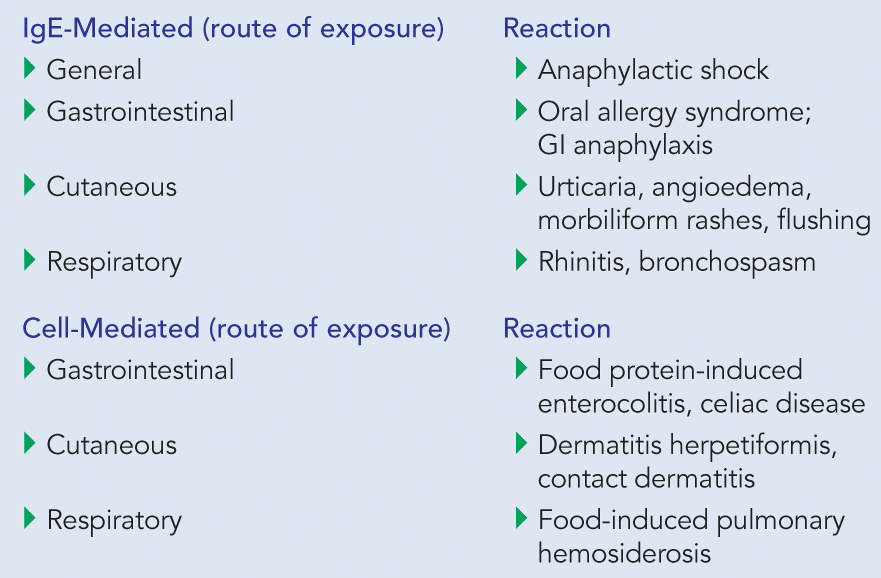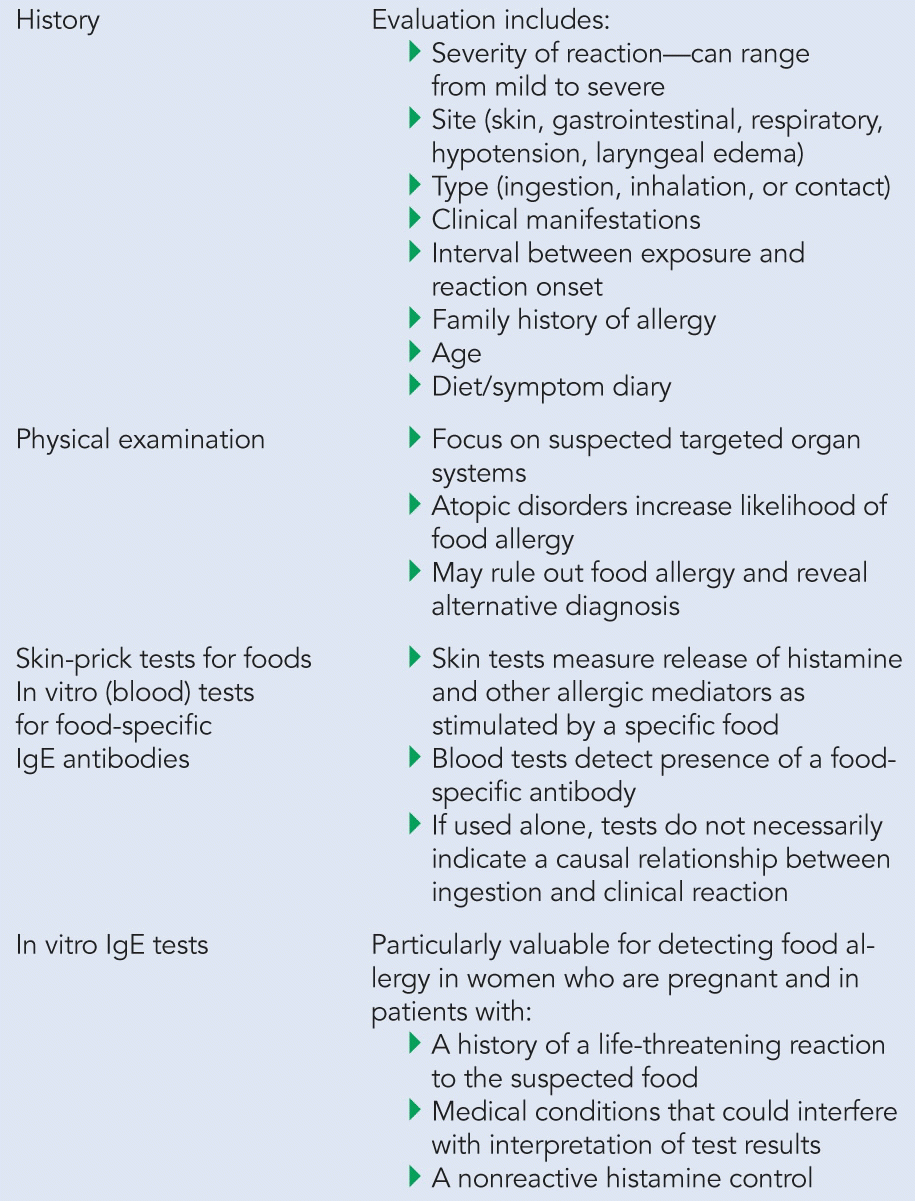With the rising prevalence of food allergies and their associated potentially fatal consequences, understanding the pathophysiology of food allergies along with their diagnosis and treatment remains a critical part of otolaryngologic practice.
Explore This Issue
December 2009During a miniseminar titled Food Allergy 2009: State of the Science at the American Academy of Otolaryngology- Head and Neck Surgery (AAO-HNS) 2009 annual meeting, sponsored by the Allergy and Immunology Committee, a panel of experts took on some tough issues of diagnosis and treatment that persist despite the large number of patients with food allergies that otolaryngologists see.
What Is Going On?
Patients with food allergies present with a spectrum of reactions, most of which represent a sensitivity to a given allergen through an immunological response either mediated by the immunoglobulin E (IgE) antigen or cell-mediated (see Table 1). Of these, IgE-mediated food reactions are the result of many of the most common food allergies with which patients present, such as peanut allergies.
According to Karen H. Calhoun, MD, of the Department of Otolaryngology- Head and Neck Surgery at Ohio State University in Columbus, one form of food allergy that otolaryngologists need to be aware of is an allergic reaction that involves an adverse reaction to ingesting an antigen that has cross-reactivity to a similar allergy marker (or epitope) on an inhaled antigen, such as pollen.
A common example of this, said Cecelia Damask, DO, of Lake Mary Ear, Nose, Throat and Allergy in Lake Mary, FL, is the situation in which a patient comes in with burning around the mouth. This could possibly be oral allergy syndrome, which is a common form of IgE-mediated food allergy, she said. Birch pollen is known to cross-react with the rose family fruits, especially apples. Local IgE-mediated mast cell activation results in immediate tingling of the lips and tongue.

This type or reaction occurs mainly with raw foods, said Dr. Calhoun, so most patients with oral allergy syndrome can tolerate, for example, applesauce or apple pie without symptoms.
An understanding of the different types of food allergies is important in first recognizing the possible routes of exposure as well as in making the differential diagnosis.
Art of Diagnosis
According to Richard Haydon, MD, of the Division of Otolaryngology in the Department of Surgery at University of Kentucky Chandler Medical Center in Lexington, most of the diagnostic tools available to diagnose food allergies are simple and relatively inexpensive (see Table 2.
The history and physical exam are important as the initial evaluation of patients to select those with a possible food allergy for whom more sensitive testing, with a skin prick or in vitro test, is then recommended. The challenge, said Dr. Haydon, is in the interpretation of these tests.
The challenge is that some people with elevated IgE antibodies don’t have clinically significant food allergies, he said, adding that both of these tests are only 50% accurate when showing a positive result. This accuracy gets better, however, if the tests indicate a huge elevation in the IgE antibodies.
If you separate the positive tests into two categories, those that are low positive and those that are very positive, the positive predictive value goes up to about 95 percent in the people with the very positive tests, he said.
He also said the tests are pretty reliable if they come out negative.
For patients in whom a diagnosis remains unclear, dietary elimination tests or oral challenge testing can also be done. However, Dr. Haydon emphasized that both tests are time-consuming and difficult to do, with no established standards on their administration and interpretation outside of a research environment.
Treatment: Avoid, Recognize, and Desensitize
Avoiding foods that cause an allergy is an easy first step in managing food allergies. However, avoidance is difficult and accidents common and deadly, emphasized William R. Reisacher, MD, Assistant Professor and Director of the Allergy Center at Weill Cornell Medical College- NewYork Presbyterian Hospital. There are a lot of hidden sources, especially to peanut allergens, he said. For example, many Asian restaurants seal their eggrolls with peanut butter, and you’d never know that.
The Food Allergy Labeling and Consumer Protection Act, issued in January 2006, requires manufacturers to disclose whether products include the top eight food allergens (ie, milk, fish, eggs, crustacean shellfish, peanuts, tree nuts, wheat, and soy). Patients should be cautious about the allergen information on food labels, as 5.3% of food products with labels warning that a specific food allergen may be contained in the product actually did contain the allergen.
 Local IgE-mediated mast cell activation results in immediate tingling of the lips and tongue.
Local IgE-mediated mast cell activation results in immediate tingling of the lips and tongue.-Cecelia Damask, DO
Given the difficulty of avoidance, one primary role of the otolaryngologist is to educate patients and their families on how to recognize the signs and symptoms of a severe food reaction and how to respond. Critical is the need for people with food allergies to carry self-injectable epinephrine at all times and to know how to use it, he said.
Along with epinephrine, omalizumab also has shown efficacy for severe allergies, according to Dr. Calhoun, although it currently is not FDA-approved as treatment for food allergies, is expensive, and must be given by injection.
Various approaches to desensitize people to specific food allergies in current use and on the horizon may offer the best treatment approach as they are geared to prevent an allergic reaction altogether. These include immunotherapy delivered either orally, sublingually, or by injection.
Injection immunotherapy has been shown to desensitize people to particular food allergens, but, according to Dr. Reisacher, despite its efficacy it is associated with an unacceptably high rate of systemic reactions.
Oral immunotherapy also has shown efficacy against some of the most common food allergies, he said, but it remains unknown whether it confers only temporary desensitization or permanent tolerance.
 The genetically modified antigen could potentially make a safer injection immunotherapy to food, and if we could make this safer it may be the holy grail for food allergy management.
The genetically modified antigen could potentially make a safer injection immunotherapy to food, and if we could make this safer it may be the holy grail for food allergy management.-William R. Reisacher, MD
Sublingual immunotherapy, which also has shown efficacy in trials, may turn out to be the most effective treatment for food allergies, according to Dr. Calhoun. It has the potential for protecting food-allergic patients from severe reactions following accidental exposure to a food, she said.
Both sublingual and oral immunotherapy for food allergies are currently used in the United States only in highly supervised research settings.
For Dr. Reisacher, one of the most exciting treatment approaches on the horizon is the use of genetically modified antigens. The genetically modified antigen could potentially make a safer injection immunotherapy to food, and if we could make this safer it may be the holy grail for food allergy management, he said.
A further potential benefit of this treatment approach is the potential for developing foods that are hypoallergenic, he said.
Use of traditional Chinese herbs is another treatment under investigation, with some data in mice showing efficacy in protecting against anaphylaxis.
Send Us Your Feedback
We’d like to know what you think about our articles. Please feel free to respond to our stories by e-mailing ENToday@lwwny.com. When writing in, please include your full name, title, phone number, and e-mail address.
©2009 The Triological Society


Leave a Reply